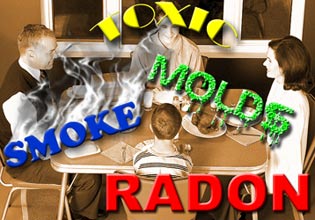
As a homeowner, you strive to make your house a safe environment for your family and friends. You use non-toxic cleaning supplies and routinely replace the batteries in smoke and carbon monoxide detectors. You keep air vents clean and use insulated electrical cords. Your house is a model of a healthy, safe home. Or, so you think.
While your home appears to be free of any obvious health hazards, there could be radon in the air you breathe and toxic molds festering behind walls, appliances like washing machines and refrigerators, sinks and other moisture rich areas. Breathing in excessive amounts of radon can cause cancer. Exposure or contact with mold can irritate your eyes, skin, nose, throat and lungs and in some instances trigger severe allergic reactions and asthma attacks. Before you start to panic, take a deep breath and relax. There are a few, simple things you can do to combat radon and mold problems before they pose any real health threat to your family.
Radon
First of all, you need to know what radon and mold are and how they get into your home. Radon is an invisible, odorless, tasteless, cancer-causing, radioactive gas. It is created by the breakdown of uranium in soil, rock and water. Found across the United States , radon can find its way into any type of building, including homes. Just because you live in a brand-new, well-built home, don't think you're safe from radon. Radon can be present in any home new or old, well-sealed and drafty homes and homes with or without basements. An estimated one out of every 15 homes in the U.S. has elevated radon levels, according to the U.S. Environmental Protection Agency (EPA). Typically, radon moves up through the ground to the air above and into the home through cracks in solid floors, construction joints, cracks in walls, gaps in suspended floors, gaps around service pipes, cavities inside walls and the water supply cracks and other holes in the foundation. Sometimes, radon enters the home through the water supply usually in instances where the water source is a well. Building materials can give off radon, but building materials rarely cause radon problems by themselves. Once the radon is inside the home, it becomes trapped and contaminates the air you breathe.
Molds
Molds are simple, microscopic organisms, present virtually everywhere, indoors and outdoors. Molds, like mushrooms and yeasts, are fungi. The presence of molds outdoors is not a bad thing. They help break down dead material and recycle nutrients in the environment. The presence of molds indoors is not necessarily a bad thing either. Molds only pose a risk to people when they are present in large numbers, which occurs primarily when there is active mold growth in the home. Usually, mold spores in the air inside homes come from outdoor sources and are not present in any concentrated levels. However, molds will grow and multiply whenever conditions are right organic material such as paper or wood is present and sufficient moisture is available. Common sources of indoor moisture that may lead to mold problems include leaky roofs, plumbing leaks, overflow from sinks or sewers, damp basements, or steam from showers or cooking.
Exposure Risks
Exposure to radon and molds can cause a myriad of health problems. When you breathe air containing radon, there's a risk you could develop lung cancer. The Surgeon General has warned that radon is the second leading cause of lung cancer in the United States today - only smoking causes more lung cancer deaths. According to the U.S. Environmental Protection Agency's (EPA) 2003 Assessment of Risks from Radon in Homes, radon is estimated to cause about 21,000 lung cancer deaths each year.
Molds can trigger asthmatic or allergic reactions and cause inflammation or infection. Exposure to molds can also cause symptoms such as:
- Respiratory problems, such as wheezing, difficulty breathing, and shortness of breath
- Nasal and sinus congestion
- Eye irritation (burning, watery, or reddened eyes)
- Dry, hacking cough
- Nose or throat irritation
- Skin rashes or irritation
Occasionally, people exposed to molds report headaches, memory problems, mood swings, nosebleeds, body aches and pains, and fevers.
Testing
The first step in ensuring molds and radon don't pose health risks in your home is to actually find out if either of them is present in large enough quantities to cause adverse affects. Testing is the only way to know if your home contains dangerous levels of radon. Inexpensive, at-home testing kits are available at hardware stores and retail outfits. You can also hire qualified professionals to do the testing for you. Oftentimes a visual check of moisture-rich areas such as your bathrooms, kitchen, window sills, and laundry room will alert you as to whether or not you have a mold problem. However, there are many places you can't see that might be home to a growing mass of mold spores - the back side of dry wall, wallpaper, or paneling, the top side of ceiling tiles, the underside of carpets and pads, areas inside walls around leaking or condensing pipes, inside ductwork, and in roof materials. A musty smell or the knowledge you had water damage in an area can alert you to the fact you may have a mold problem. Should you believe you have a hidden source of mold in your home, you can hire professionals to conduct testing.
Reduction Methods
There are a variety of methods you can utilize to reduce the radon level if testing indicates it's too high. In some instances, sealing cracks in floors and walls may help to reduce radon levels. In other instances, you may need to install a vent pipe system and fan, which pulls radon from beneath the house and vents it to the outside. For mold, you'll need to hire professional cleaners if the problem is widespread or in hard to reach areas like behind walls. You can remove small amounts of mold from hard surfaces by scrubbing with detergent and water and drying the area thoroughly. If you plan to tackle a mold problem yourself, be sure to take the necessary safety precautions. The EPA advises that when trying to remove mold, you wear gloves, goggles and an N-95 respirator, which is available at many hardware stores and over the Internet.
Conclusions
In order for a home to be a healthy and safe environment, homeowners have to focus their attention not just on what they can see, but also what they can't see. Detecting the presence of radon and molds isn't hard so why risk putting you and your family's health at risk?
 Print
Print Email
Email







